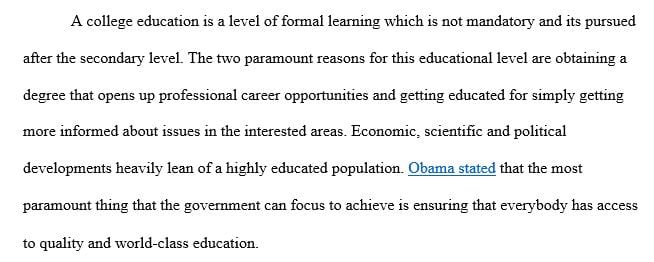Create a multimodal argument that aims (1) to educate an audience of non-engaged stakeholders
Implementing Free College Education in The United States
This paper asks you to create a multimodal argument that aims (1) to educate an audience of non-engaged stakeholders about the topic you have been exploring, (2) to engage this audience by convincing them that they should care about this issue, and (3) to empower the audience to agree to your call to action.
You’ll construct this multimodal argument by combining two or more channels or systems of communication that include (1) writing text as argument (2) incorporating static images, and (3) connecting a dynamic visual or auditory component via a hyperlink.
Together, in one unified multimodal argument, all three communication modes will (1) educate an audience of non-engaged stakeholders about the topic you have been exploring, (2) engage this audience by convincing them that they should care about this issue, and (3) empower the audience to advance your cause by taking action in some defined way.
More specifically, your multimodal argument requires
a textual construction that includes linguistic and spatial constructions in the writing of a 1,100 – 1,300-word essay in MLA style that incorporates compelling and persuasive evidence that supports your thesis;
a visual component, which strategically integrates a total of two static images (photograph, diagram, infographic, graph, map, and/or drawing) that support your argument in important ways. Vary the type of static visuals to avoid including two of the same type;
one dynamic media component via a hyperlink of an appropriate word or phrase that intentionally merges a single video or podcast of two minutes or less into your multimodal argument in meaningful ways.
Points to remember when using visual images (note: you’re making rhetorical choices for everything you do in your multimodal argument, and guiding your audience is one of those conscious choices):
Placement of the static images and your one hyperlink are critical to the effectiveness of the multimodal argument. Images should be large enough (but not overpower the text) to be seen clearly, be of good quality/resolution, and be positioned near the text that the images or hyperlink reference. Be aware the relationship between the text and the image should be clear. In other words, you should reference the image in the text in a way that advances why the image matters to the argument being conveyed. Wrap the text squarely or tightly around the image. Label all visuals with a relevant title and caption that explains the argument of the visual.
Give credit to the original source when using images, including bibliographic information in your Works Cited page. Refer to the required formatting guidelines for citing visuals.
Introduce your dynamic visual with a hyperlink, which will allow your audience to connect to the video or podcast. Hyperlink an appropriate word or phrase in a sentence of your text that links directly to the dynamic visual. As you referenced your static images in the text, you will also connect the dynamic image or podcast (introduced by your hyperlink) to the larger multimodal argument being conveyed. Reference this source in your Works Cited Page.
At least five credible sources are required for this Intermediate Draft of your Multimodal Argument. You can draw on the relevant research conducted in the last two projects; however, you must include at least 3 new sources that you have not previously used. In addition to these 5 sources, you will document the 3 sources associated with your 2 static visuals and your hyperlink connection.
The following processes will help you to further develop your Part 2 Intermediate Multimodal Argument:
Begin with a creative and transparent title that reflects the critical nature of your research topic and your objective to persuade your audience to agree with your call to action.
Contextualize your chosen topic in your introduction. Identify the problem related to your topic, let your audience know why your topic is important and why they should care, and include a call to action thesis that concludes what you determine is a reasonable solution to the problem you have conveyed.
Provide a progression of ideas/evidence/appeals in a logical and cohesive pattern in the body of your essay, introducing each paragraph with a topic sentence that positions an important point. Follow each topic sentence with supporting evidence from your research to support your claim. Be sure to anticipate your audience’s objections with a meaningful refutation and logically lead your audience to the call to action. Integrate appropriate evidence from your 5 sources, anchoring your ideas with support by the source’s arguments.
Integrate a total of two static images, photographs, diagrams, infographics, graphs, maps, and/or drawings, that support your argument in important ways. Vary the type of static visuals to avoid including two of the same types.
Include a hyperlink that intentionally connects an appropriate word or phrase to one dynamic media component, which may be a single video or podcast of two minutes or less into your multimodal argument in meaningful ways.
Be sure to use clear transitions as you move from point to point.
Provide source citations according to the required guidelines.
Write a conclusion that highlights your major points and provides realistic forward-thinking ideas for future research/action.
Include a Works Cited page
Answer preview to create a multimodal argument that aims (1) to educate an audience of non-engaged stakeholders
APA
1051 words


